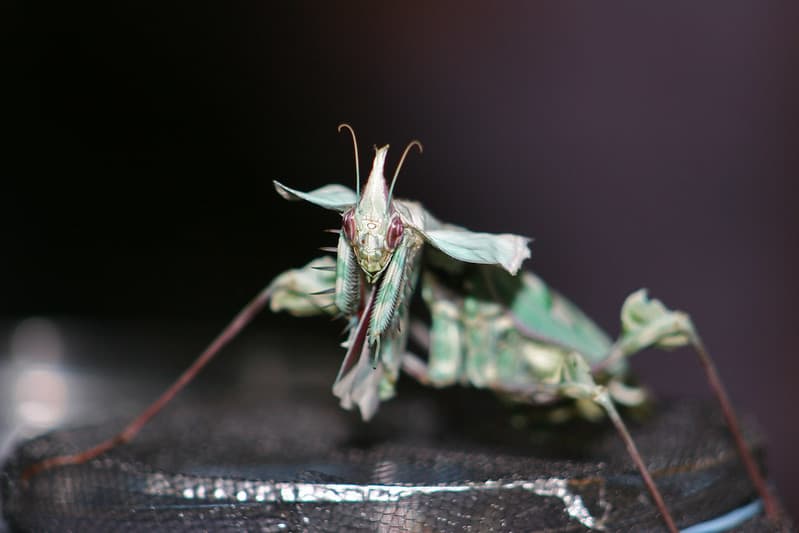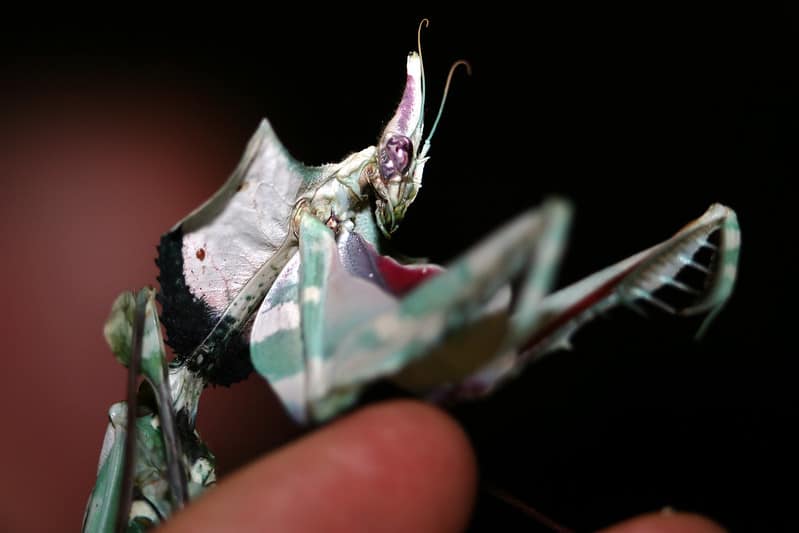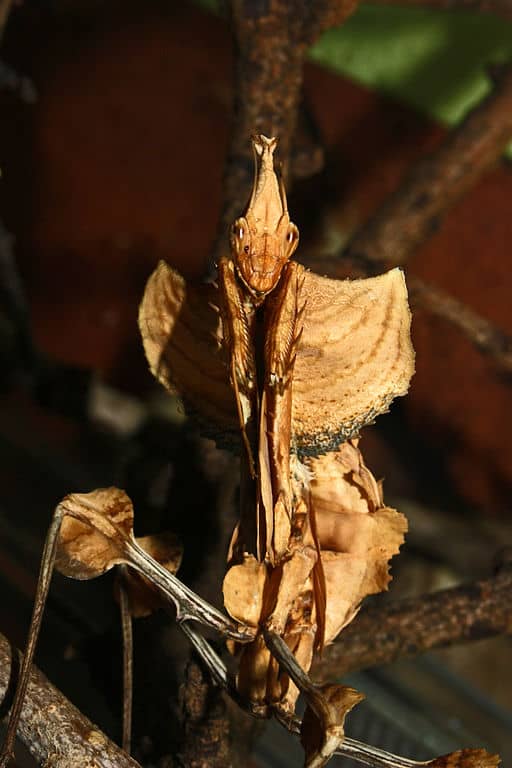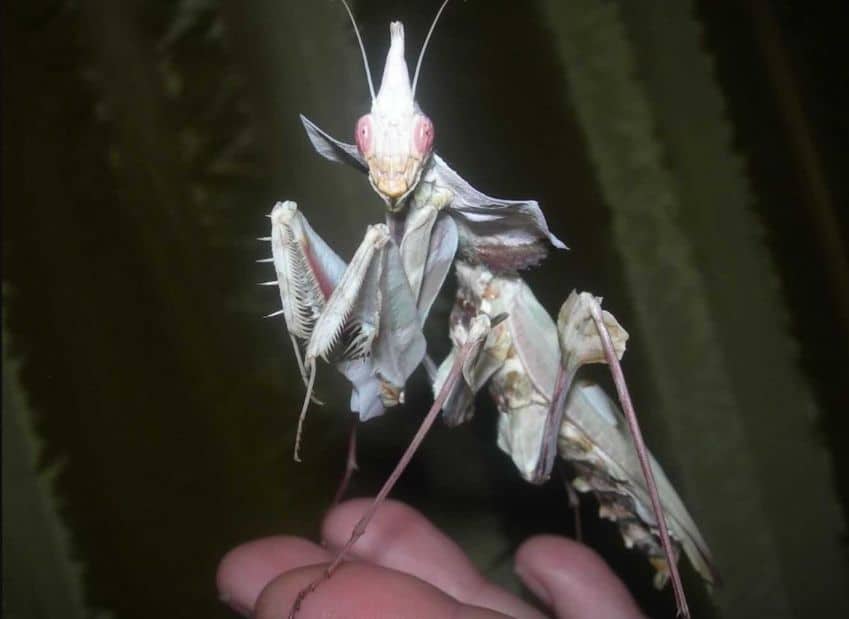The Devil’s Flower Mantis (Idolomantis diabolica) is a beautiful mantis species native to Africa. This species is famed for its large size, beautiful colors, and unique appearance, all of which make them highly desired among insect collectors.
However, while this species is definitely beautiful, its stunning appearance does come with a price tag. They’re among the more expensive mantis species and are notoriously difficult to care for.
If you’re considering adding a Devil’s Flower Mantis to your collection, you’ve come to the right place. We’ll tell you everything you need to know about this beautiful insect so that you can properly care for them.

Devil’s Flower Mantis Care Sheet
| Name of species | Idolomantis diabolica |
| Family | Empusidae |
| Common name | Devil’s Flower Mantis |
| Category | Mantis |
| Native location | Ethiopia, Kenya, Tanzania |
| Temperature | 85°F to 104°F |
| Humidity | 40% to 50% |
| Size | Females: 5 inches / Males: 4 inches |
| Diet | Flies |
| Lifespan | 12 months |
| Experience level | Advanced |
Devil’s Flower Mantis Overview
The Devil’s Flower Mantis is known scientifically as the Idolomantis diabolica. It inhabits a wide range of countries in the African continent. There, it lives in twigs and trees and waits in camouflage for flies to pass by. As the flies pass by the mantis, she snatches them out of the air at lightning speed before devouring them with her strong mandibles.
They’re excellent hunters and watching them catch flies is truly a remarkable sight to behold.
Appearance & Variations

The Devil’s Flower Mantis is a large species. Females can grow to a size of up to 5 inches. Males are slightly smaller and typically grow to a size of around 4 inches.
The nymphs of this species look very different than the adults. When they first hatch, the nymphs are orange in color. As their exoskeleton hardens, they display a dark black color that closely resembles that of an ant. It is speculated that this color is used so that the nymphs can mimic being an ant in order to deter predators.
As the nymphs grow older they trade their shiny black color for a beige to light brown color. During this stage of their life, they’re quite dull-looking. It is not until they become adults that they show their true beauty.

Adult Devil’s Flower Mantises are truly remarkable to look at. Not only have they reached their characteristic large size, but they’re also starting to display some truly remarkable colors. The primary colors that they display as adults are white and green. Their arms have red, white, black, and blue markings. These colors on their arms are not visible when they’re in a relaxed, non-threatened state, but when they feel threatened they will put up a threat pose and these colors will become visible.
In addition to colors, another characteristic feature of this species is that they grow appendages on their body that help them resemble a flower. This is done for stealth as it allows them to hunt better.
Male and female Devil’s Flower Mantises are quite similar in appearance to one another, but there are a few key differences. First, males are typically a bit smaller and more slender, though the size difference is not big enough to accurately tell them apart. Secondly, males have big feathered antennae while those of females are long, thin, and straight.
The best way to tell males and females apart is by looking at the abdominal segments. Males have 8 when fully grown, whiles females have 6 or 7.
Temperament & Behavior
With a name like “Devil’s Flower Mantis”, an imposing size, and a threatening appearance you might think that this species is defensive and courageous, but that’s not really the case.
Whenever this mantis notices something that it perceives as a threat its first instinct is always to run away or show a threat posture. The threat posture is beautiful to look at due to the colors it displays, but it does signify that your mantis feels threatened which is very stressful for them. Stress is bad for mantises, as it can lower their lifespan.
Unfortunately, this species gets scared quite easily. They can perceive anything from pets, to humans, to sudden movements as threats that will cause them to run away.
Because they’re so easily frightened, it’s not recommended to handle this species as it causes them unnecessary stress. In addition, it’s important that you provide them with a calm and stress-free environment so that they can relax.
When it comes to hunting, they’re very interesting to watch. If they notice that prey is nearby they will remain motionless in order to impersonate a flower. They do this in order to lure the prey close to them so that they can strike. Once the prey is within striking distance, the mantis will use its claws to grab the fly from the air and eat it.
These mantises are not dangerous to humans. They can bite if they’re being handled, but they’re not venomous. Adults may be able to pierce the skin and draw blood, but it’ll only hurt slightly, that’s it.
Price
The Devil’s Flower Mantis is one of the most expensive mantis species around because they’re quite hard to breed and in high demand. As a result, if you’ve been looking for a Devil’s Flower Mantis for sale you might have noticed that prices are high and that they’re very often sold out.
If you do find a breeder that has them in stock, you can expect to pay anywhere between $40 and $200 depending on age, sex, and the breeder you buy from.
Caring for a Devil’s Flower Mantis

While most mantids are quite easy to care for, the Devil’s Flower Mantis has certain requirements that make it quite difficult to adequately care for.
Here’s what they need in order to thrive.
Tank setup
As is the case with all mantis species, the minimum enclosure for the Devil’s Flower Mantis can be calculated by taking the length of the specimen and multiplying it by 3 for the height and by 2 for the width. This gives us a minimum enclosure size of around 15 inches high and 10 inches wide for an adult female.
However, keep in mind that this is a minimum size. This mantis needs quite a lot of space, so a bigger enclosure is recommended.
You can choose to create a bioactive enclosure or keep it simple by just decorating their cage with a lot of sticks and dry leaves. Due to this species’ skittish nature, they really appreciate having a lot of sticks and other foliage in their enclosure as it allows them to hide whenever they feel threatened.
An interesting thing about the Devil’s Flower Mantis is that they’re unable to climb on glass because they do not have the feet for it. As a result, they need plenty of sticks and branches to be able to climb and hang from. Additionally, you can choose to use a mesh enclosure rather than a glass one.
Temperature, Humidity & Ventilation
One of the reasons why the Devil’s Flower Mantis is hard to care for is the fact that it requires a very high temperature. These insects are native to Africa, where the temperatures are very high. In captivity, you need to closely resemble their natural climate in order for them to feel comfortable.
This means that you should provide them with a temperature between 85°F to 104°F with the ideal temperature for them being around 95°F. At night, the temperature can be lower at around 70 °F.
Since most people do not live in a house that has such a high ambient temperature supplemental heating is required. To do this, you can use heat mats or heat lamps.
As for humidity, aim for a minimum of 40% to 50% relative humidity. To keep the humidity up, you have to spray the enclosure. In addition, you can place a shallow dish of gravel that’s filled with water sunk into the substrate. The evaporation will help keep humidity levels up.
In addition, ventilation is also very important. If you do not ventilate their enclosure properly, the high temperatures and humidity will cause mold growth.
Due to these requirements, the Idolomantis diabolica is quite hard to keep. You have to keep the temperature, humidity, and ventilation at adequate levels, which is difficult due to the fact that increasing the temperature and ventilation decreases humidity.
As a result, many of these insects die as nymphs before ever reaching adulthood. This, combined with their expensive price means that it’s important that you do a lot of research before purchasing one. In addition, it’s a good idea to have some experience keeping easier mantis species before trying your hand at this particular one.
Substrate
The Devil’s Flower Mantis needs a layer of substrate of about 1 to 2 inches thick on the bottom of their enclosure.
Substrate that’s suitable for this species should be absorbent, keep humidity stable, and not mold easily. A great option is coconut fiber, since it is sterile, maintains humidity well, and is cheap. Soil and paper towels can also work in a pinch, but are not the preferred option.
Do make sure if you use paper towels that you change them frequently. If you use soil, make sure that you buy one that does not contain pesticides or fertilizer. In addition, it’s a good idea to sterilize it in the microwave or over first before using it.
On the whole, coconut fibers are easy to find and are without a doubt the best option. The others should only really be used when you have no other option.
Watering
To keep the humidity up you will have to mist the Devil’s Flower Mantis enclosure frequently. At least once a day the enclosure has to be sprayed, or twice a day if you keep them in a mesh enclosure. Mantises do not like getting wet, so make sure to spray around the animal, not on them. If you do get some water on them, it’s not a big deal as they will dry in no time in their warm enclosure.
When misting, it’s best to use spring water or distilled water. Tap water is not recommended.
The misting is not only important to keep the humidity up, but also because the droplets that form allow your mantis to drink. The majority of the mantis’ water intake will come from the food they eat, but they also supplement their water intake by drinking from droplets.
Diet & Feeding
Due to their hunting style, you should feed your Devil’s Flower Mantis exclusively with flying insects. They will ignore non-flying insects unless they come within striking range and the mantis is very hungry. However, even though they will eat other, non-flying insects if they have no other choice, they’re not good for them.
Almost their entire diet should consist of flies, but the flies they should eat depends on what stage of their life they’re in.
- L1 nymphs should be fed small fruit flies.
- L2 and L3 nymphs should eat slightly larger fruit flies.
- L4 and L5 nymphs should eat house flies or blue bottle flies.
- L6 nymphs to adults should eat blue bottle flies.
The Devil’s Flower Mantis is a strong eater with a healthy appetite and can be fed every day.
Molting
Your Devil’s Flower Mantis will molt several times throughout its life. For the Devil’s Flower Mantis, the molting process is quite difficult. Many owners report that their mantis has died during a molt and it’s also possible for them to lose a limb during a failed molt. As such, it’s important that you provide them with a good environment to molt in.
Things that your mantis needs to molt properly are an enclosure that’s humid enough and a place to hang upside-down from.
When it’s time for them to molt, you’ll notice that they will not eat. This is normal as it makes the molting process easier. Then, they will hang motionlessly upside down and begin the molting process. During this time, it’s important that you do not disturb them or stress them out as this can lead to a failed molt.
Once the molt is completed, refrain from feeding them for around 24 hours to give their exoskeleton time to harden.
Health & Lifespan
While most mantis species are relatively hardy and easy to care for, the Devil’s Flower Mantis it is quite the opposite. The environment they need is hard to simulate in captivity, which leads to many of these insects dying prematurely in captivity.
If you do manage to provide them with everything they need, they can live for about 12 months.
To keep them healthy, the most important things are keeping up the temperature, humidity, and ventilation and giving them a good enclosure and food. Make sure that their diet consists of flies and that the flies you feed them are captive-bred from a reputable source.
You should also make sure that they have as little stress as possible. Ideally, you should also refrain from handling them to avoid stress.
Communal living
The Devil’s Flower Mantis is one of the few mantids that can be housed communally. They’re less prone to cannibalism than other species, though the risk of it happening does always exist.
To minimize the risk of cannibalism, it’s very important that you provide them with plenty of food and enough space in their enclosure. In addition, it’s important that all the mantises that are housed communally are similar in size.
If you choose to create a bioactive enclosure, you can also house your Devil’s Flower Mantis with other insects such as non-climbing cockroaches, millipedes, and isopods.
These insects are great to house with your mantis because they’re terrestrial, meaning that they won’t bother your mantis and your mantis won’t eat them. In addition, they’re the janitors of the animal kingdom and will work hard to consume any mold growth that might occur in the enclosure, which helps keep the enclosure suitable for your mantis.
Breeding the Devil’s Flower Mantis
If you house your Devil’s Flower Mantis communally, mating will happen naturally. However, the adults will often eat the nymphs so it’s important that you remove the ootheca (egg sac) after mating if you want to raise the mantis into adulthood.
If you do not house them communally, you will have to identify a male and a female. This can be done by looking at the abdominal segments. Adult males have 8 while females have 6 or 7. If these males are 2 to 4 weeks into adulthood, they’ll be ready to mate.
Once you’ve identified a male and a female that are ready to mate, make sure that they’re well-fed, especially the female, as this reduces the chances of cannibalism. Since this species is skittish, it might take a while for them to mate, but it will usually happen at night.
Once the mating is successful, after a few days the female will produce the first egg sac (ootheca). In total, the female will produce about 7 oothecae. These oothecae will be produced once every 2-3 weeks after mating.
When an egg sac is produced, you can either remove the female from the enclosure or remove the egg sac. When removing the egg sac, place it in an enclosure with similar conditions that you keep the adult mantis in. Ventilation is very important, as mold can kill the egg sac.
Fun Devil’s Flower Mantis Facts
- The Idolomantis diabolica was first described in 1869 by Saussure as the Idolum Saussure but has had a few name changes since then.
- The Devil’s Flower Mantis is one of the largest praying mantises and it might be the largest that mimics flowers.
- The Idolomantis diabolica is the sole member of its genus.
Final words
The Devil’s Flower Mantis is a beautiful, big species that is extremely interesting to watch. However, their beauty and size do come with a price tag. Not only are they quite expensive, but they’re also difficult to care for. They’re easily startled and stressed, and they require an environment that can be difficult to simulate in captivity.
As a result, they’re not very suitable for people who are new to keeping mantises as pets. For beginners, species such as the Ghost Mantis or Carolina Mantis are much more suitable because they’re easier to care for.
However, if you’ve got what it takes, caring for this mantis is a very rewarding challenge!
- How Long Do American Eskimo Dogs Live? Important Factors and Care Tips - September 29, 2023
- Do American Bulldogs Need Grooming? Essential Tips and Care Guidelines - September 29, 2023
- Do Bengal Cats Enjoy Playing? Essential Tips for Keeping Them Active - September 29, 2023